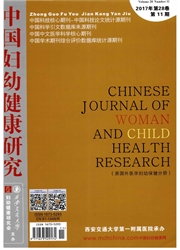

 中文摘要:
中文摘要:
目的 通过对足月缺氧缺血性脑病患儿和正常足月儿头颅常规核磁共振检查结果 的分析,探讨后外侧豆状核与内囊后肢在T1加权上的信号强度改变对新生儿缺氧缺血性脑病的诊断价值.方法 选择西安交通大学医学院第一附属医院新生儿科收治的足月新生儿缺氧缺血性脑病患者20例作为实验组,同期出生的正常足月新生儿7例作为对照组,两组新生儿均在其出生后3~12天内行常规核磁共振检查.结果 后外侧豆状核的信号强度高于或等于内囊后肢的信号强度,实验组与对照组之间的比较差异有显著的统计学意义(χ^2=8.703,P〈0.01).结论 头颅核磁共振检查中后外侧豆状核的信号强度高于或等于内囊后肢的信号强度时,对缺氧缺血性脑病的诊断具有重要意义.
 英文摘要:
英文摘要:
Objective To investigate diagnostic value of contrast of signal intensity (SI) between postero-lateral lentiform nucleus and posterior limb of internal capsule on T1 -weighted images of MRI for brain injury caused by hypoxic-ischemic encephalopathy(HIE) of term neonates and normal trem neonates. Methods 20 term neonates with HIE who admitted to Department of Neonatology of The First Affiliated Hospital of Medical College, Xi' an Jiaotong University were selected as HIE group, at the same time, 7 normal neonates without a history of perinatal asphyxia or other episodes that might provoke hypoxic-ischemic brain damage were selected as control group. All the infants received MRI at 3 - 12 days after birth. Results The SI of postero-lateral lentiform nucleus is equal to or higher than the SI of posterior limb of internal capsule, there was significant difference between the HIE group and the control group (X^2 = 8. 703, P 〈 0.01 ). Conclusion That the SI of postero-lateral lentiform nucleus is equal to or higher than that of posterior limb of internal capsule on T1-weighted images of the cerebral MRI is of important significance for the diagnosis of HIE.
 同期刊论文项目
同期刊论文项目
 同项目期刊论文
同项目期刊论文
 期刊信息
期刊信息
